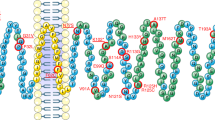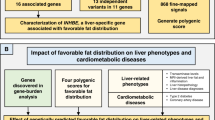Abstract
Replying to: J. R. Speakman Nature 464, 10.1038/nature08807 (2010)
The human studies on FTO reported an association of an intronic single nucleotide polymorphism (SNP) with obesity. Our report of mice with the targeted inactivation of the Fto gene demonstrated a direct role of Fto in energy homeostasis1. We have shown that the absence of Fto protein results in leanness and that Fto deficiency affects energy homeostasis. Speakman2 exemplifies that the experiments performed in mice1 conflict with results in humans carrying the FTO risk allele presenting hyperphagia and increased caloric intake3,4,5,6,7,8,9.
Similar content being viewed by others
Main
The majority of studies examining the effects of FTO risk SNPs and determinants of adiposity in humans have reported association with food intake and/or appetite, and none has reported a significant effect on energy expenditure. However, the effects are modest in size and the precise measurement of the components of energy balance in human is fraught with difficulty, so it would therefore be premature to state conclusively that FTO affects human adiposity only through an effect on food intake.
With respect to the analysis of energy expenditure in our mouse model, correction of energy expenditure, that is, O2 consumption to lean body mass, represents at this point a standard procedure in mouse phenotyping. This kind of data analysis was specifically requested by the reviewers of our manuscript. Another group has since reported the generation and analysis of a mouse model carrying a point mutation in the murine Fto gene as a consequence of N-ethyl-N-nitrosourea mutagenesis10. The phenotype of this mouse line closely resembles the knockout phenotype1, although the alterations in overall body size are much more moderate.
However, this model also presents reduced fat mass and resistance to high-fat-induced obesity. Notably, in line with our report, even in the absence of major weight differences and with unaltered lean mass, mice carrying the Fto point mutation show increased energy expenditure as reported for the knockout model10.
Taken together, our report on Fto-deficient mice provides a direct study on the role of the Fto protein in the absence of dysregulated Ftm (also known as Rpgrip1l) expression, the key findings of which have already been reproduced in an independent mouse model with altered Fto function. The observed reduction in fat mass does represent an important step towards the further understanding of FTO biology and we are confident that this and other mouse models will provide important additional insights into the function of FTO in the near future.
References
Fischer, J. et al. Inactivation of the Fto gene protects against obesity. Nature 458, 894–898 (2009)
Speakman, J. R. FTO effect on energy demand versus food intake. Nature 464, 10.1038/nature08808
Speakman, J. R., Rance, K. A. & Johnstone, A. M. Polymorphisms of the FTO gene are associated with variation in energy intake, but not energy expenditure. Obesity (Silver Spring) 16, 1961–1965 (2008)
Wardle, J. et al. Obesity associated genetic variation in FTO is associated with diminished satiety. J. Clin. Endocrinol. Metab. 93, 3640–3643 (2008)
Timpson, N. J. et al. The fat mass- and obesity-associated locus and dietary intake in children. Am. J. Clin. Nutr. 88, 971–978 (2008)
Do, R. et al. Genetic variants of FTO influence adiposity, insulin sensitivity, leptin levels and resting metabolic rate in the Quebec Family Study. Diabetes 57, 1147–1150 (2008)
Haupt, A. et al. Variation in the FTO gene influences food intake but not energy expenditure. Exp. Clin. Endocrinol. Diabetes 117, 194–197 (2009)
Wardle, J. et al. The FTO gene and measured food intake in children. Int. J. Obes. 33, 42–45 (2009)
Cecil, J. E. et al. An obesity associated FTO gene variant and increased energy intake in children. N. Engl. J. Med. 359, 2558–2566 (2008)
Church, C. et al. A mouse model for the metabolic effects of the human fat mass and obesity associated FTO gene. PLoS Genet. 5, e1000599 (2009)
Author information
Authors and Affiliations
Ethics declarations
Competing interests
The authors declare no competing financial interests
Rights and permissions
About this article
Cite this article
Fischer, J., Koch, L., Emmerling, C. et al. Fischer et al. reply. Nature 464, E2 (2010). https://doi.org/10.1038/nature08808
Issue Date:
DOI: https://doi.org/10.1038/nature08808
Comments
By submitting a comment you agree to abide by our Terms and Community Guidelines. If you find something abusive or that does not comply with our terms or guidelines please flag it as inappropriate.



